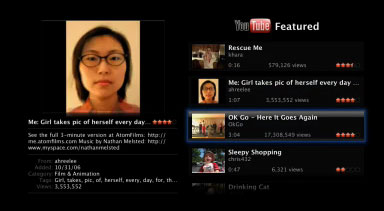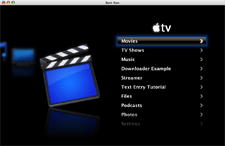 We recently wrote about the plethora of unnoficial AppleTV hacks to have surfaced on the Internet, including a plug-in that brought YouTube access to Apple’s set-top-box. As of today that particular hacker can take a well earned rest (or move onto another cool project) because Apple will soon release an update which enables the device to browse, search, and playback YouTube content.
We recently wrote about the plethora of unnoficial AppleTV hacks to have surfaced on the Internet, including a plug-in that brought YouTube access to Apple’s set-top-box. As of today that particular hacker can take a well earned rest (or move onto another cool project) because Apple will soon release an update which enables the device to browse, search, and playback YouTube content.
From the press release:
Beginning in mid-June, Apple TV will wirelessly stream videos directly from YouTube and play them on a user’s widescreen TV. Using Apple TV’s elegant interface and simple Apple Remote, viewers can easily browse, find and watch free videos from YouTube in the comfort of their living room.
Also of note is that users will be able to log-in to their YouTube accounts from the AppleTV so that they’ll be able to view and save their favorite videos.

YouTube support on the AppleTV is something that I’ve called for right from the start, and in many ways I’m not surprised to see Apple add this new feature. One of the reasons that the hackers have had so much joy developing unofficial add-ons is because the AppleTV’s software already has a plug-in architecture — suggesting that Apple always intended to roll out new functionality. (What upgrades do you think we’ll see next? Let us know in the comments.)
In more AppleTV-related news, Apple now offers a build-to-order version of its set-top-box with the option of a 160GB hard drive — priced at an extra $100 ($399). Nice!
 Sporting a 10inch screen and full-size keyboard, Palm’s new device
Sporting a 10inch screen and full-size keyboard, Palm’s new device  The second big announcement at the opening day of the D: All Things Digital conference (following Microsoft’s
The second big announcement at the opening day of the D: All Things Digital conference (following Microsoft’s  After announcing earlier in the year that in partnership with EMI, Apple was to start selling DRM-free tracks on iTunes, today the company declared its ‘iTunes Plus’ store open for business. The ‘Plus’ of course refers to the fact that the songs offered will not only be without Digital Rights Management (DRM) — the technology that restricts what you can do with your music, such as how many copies you can make or which devices it will playback on — but also that they will be encoded at a higher audio quality, and cost 30 cents more per-track.
After announcing earlier in the year that in partnership with EMI, Apple was to start selling DRM-free tracks on iTunes, today the company declared its ‘iTunes Plus’ store open for business. The ‘Plus’ of course refers to the fact that the songs offered will not only be without Digital Rights Management (DRM) — the technology that restricts what you can do with your music, such as how many copies you can make or which devices it will playback on — but also that they will be encoded at a higher audio quality, and cost 30 cents more per-track. Microsoft just announced a very cool new multi-touch computing product, called
Microsoft just announced a very cool new multi-touch computing product, called  Update: news has just come out about the product described below, officially named
Update: news has just come out about the product described below, officially named 
 In a recent post titled ‘
In a recent post titled ‘ YouTube’s embeddable flash video player is being given a makeover that adds improvements to its user interface, along with some additional functionality. The unofficial Google blog,
YouTube’s embeddable flash video player is being given a makeover that adds improvements to its user interface, along with some additional functionality. The unofficial Google blog,  With an ever greater amount of video being consumed online, many Internet users are in for a shock. There’s a dirty little secret in the broadband industry: Internet Service Providers (ISPs) don’t have the capacity to deliver the bandwidth that they claim to offer. One way ISPs attempt to conceal this problem is to place a cap of say 1GB per-month per user, something which is common in the UK for many of the lower-cost broadband packages on the market. Considering that a mere three hours viewing of Joost (the new online video service from the founders of Skype —
With an ever greater amount of video being consumed online, many Internet users are in for a shock. There’s a dirty little secret in the broadband industry: Internet Service Providers (ISPs) don’t have the capacity to deliver the bandwidth that they claim to offer. One way ISPs attempt to conceal this problem is to place a cap of say 1GB per-month per user, something which is common in the UK for many of the lower-cost broadband packages on the market. Considering that a mere three hours viewing of Joost (the new online video service from the founders of Skype —